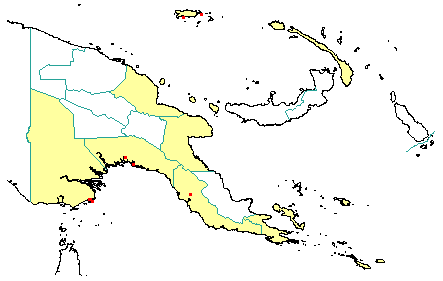
in PNGplants database
PNGTrees – Rhizophora mucronata Lam. |
Barry Conn (NSW) & Kipiro Damas (LAE).
Copyright held by the authors, Royal Botanic Gardens and Domain Trust, and Papua New Guinea National Herbarium
Encyclopédie Méthodique, Botanique 6 (1804)
Other Literature: M. Percival and J.S. Womersley, Floristics and Ecology of the Mangrove Vegetation of Papua New Guinea 81-82 (1975)
Field Characters: Small trees 5-10 m high or large trees 15-32 m high. Bole cylindrical 20-60 cm diam.; straight bole 18 m long; buttresses absent; spines absent; aerial roots absent or present; stilt roots present up to 3 m high, rarely up to 8 m high, occurring in the crown. Bark dark brown, grey pale to dark, or greyish black, rough, coarsely fissured with longitudinal and horizontal fissures; subrhytidome dark red; blaze consisting of one layer; faintly to non-aromatic; outer blaze red or brown, markings absent, granular without splinters; inner blaze red or brown, markings absent, granular without splinters; exudate absent. Terminal buds not enclosed by leaves; complex hairs absent; stinging hairs absent; mature twig without hairs.
Leaves: Clustered at end of branches <internodes indistinct>. Leaves spiral, simple; petiole present 15-40 mm long, not winged, attached to base of leaf blade <not peltate>, not swollen; lamina broadest at or near middle, (6.5-) 8.0-23.0 cm long, (3.0-) 5.0-13.0 cm wide; lamina symmetric, margin entire, not dissected or lobed, apex obtuse or mucronate, venation pinnate <secondary veins arising from the midrib along its length>, secondary veins open <spaced far apart to easily see tertiary veins>, not prominent, but visible, intramarginal veins absent; lower surface green, upper surface dull dark green, hairs absent; oil dots present on lower surface; domatia absent; stipules present, joined, joined across twigs <growing between opposite leaves and leaving a scar between them when they fall; interpetiolar>, encircling the twig <amplexicaul>, leafy, not fringed, large <easily visible to the eye> (2.5-)5-8.5 mm long, not persistent.
Flowers: Inflorescence axillary <from between a leaf and branch> or on the trunk or branches <cauliflorous-ramiflorous> often on branchlets below leaves. Flowers on a branched axis inflorescences 2-5-flowered; flowers bisexual, stalked pedicel 3-5 mm long, with many planes of symmetry <actinomorphic>, 10.0-15.0 mm long, large (>10 mm diam.) 10-15 mm diam.; perianth present, with distinct sepals and petals, cream-coloured or white; inner perianth 4, free; stamens 8, filaments present short, free of each other, joined to perianth <epipetalous/episepalous> ovary partly inferior <perigenous>, carpels joined (when more than one) <syncarpous>, locules 2; styles absent or solitary <including joined together> up to 6 mm long, 1.
Fruits: Fruits arranged on branched axis. Fruit 25-70 mm long, 12.0-17.0 mm diam., fruit greenish brown dull, not spiny, slightly fleshy, simple, indehiscent, drupe. Seeds 1 (-3), much more than 10 mm long at least 20 mm long, not winged, as wide as long or longer than wide, >10 mm diam. about 20 mm diam.
Distribution: Gulf, Madang, Western, Papuan Islands, Manus, New Ireland, Central, Morobe & Milne Bay.
 | Botanical records in PNGplants database |
Notes: Rhizophora stylosa Griff. is here included in R. mucronata.